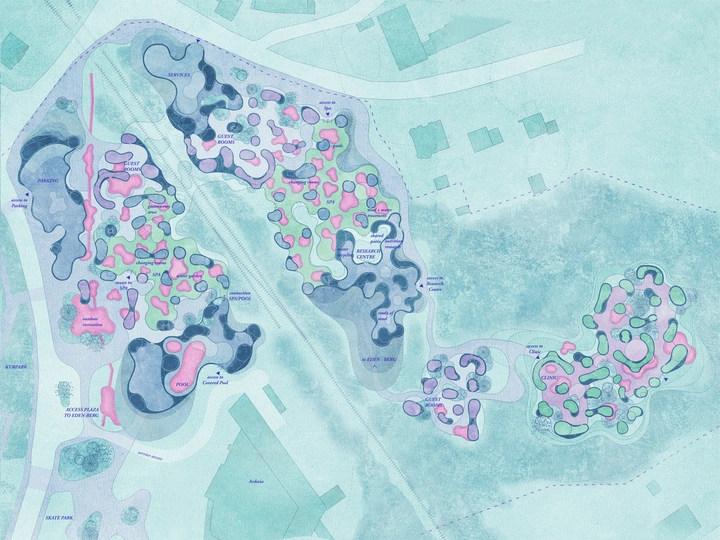EDEN BERG: A topography of new bathing experiences

Violeta Ordoñez
Raquel Ruiz
The team met at the Architecture School in Madrid and have since kept collaborating. Through design, they explore and learn other ways of becoming socially helpful and enhance participation, freedom of use, and appropriation. Each of them has implemented projects and successfully participated in a variety of competitions within the architecture offices they have collaborated with. WATEREVER STUDIO is the perfect match to materialize dreams, ideals, programs and concepts they together pursue. Together they have been awarded at Europan 16 and 17.
Monica Lamela is the founding principal of There There: an architecture studio that fluctuates between design and research, and between Los Angeles, Mexico City, and Madrid. Through architectures, counternarratives, and fictions the practice materializes alternative imaginaries, challenges dominant worldviews, and catalyzes meaningful experiences. There There work has been recognized with the AIA Next LA Award, Architectural Newspaper Best of Design Award, and the Architecture + Design Museum of Los Angeles Design Awards.
Violeta Ordóñez began her professional career in Shanghai. There she was able to experience architecture and life out of her comfort zone. Eventually, she returned to Madrid to keep exploring and learning, through the design, other ways of becoming socially helpful. An example of this could be the project CentroCentro’s Hall. Along with architecture projects, she has also taken part of the alternative art scene in Madrid exhibiting her ceramics at the first opening of Casa Antillón.
Raquel Ruiz has worked at architecture, curatorial and graphic design offices. She is interested in an interdisciplinary practice that entangles sustainability, public engagement, design and construction. To that end, she has taken part in experimental workshops in Brazil, China, Japan and Germany. In her practice she seeks for context, detail and thoroughness in order to develop a more versatile and functional architecture.
EDEN-BERG is a forested mountain that echoes the existing iconic hills that characterize Bad Lobenstein’s topography. Slate hiking trails traverse the mountain and connect EDEN-BERG with Kurpark, the town center, Stadtteich pond, ARDESIA baths, and Moorspatscher Weg, generating a comprehensive network of pathways throughout the region. From the top of the new mountain, Bad Lobenstein and its iconic mountains can be rediscovered from a new vantage point. At the foothills of EDEN-BERG new wetlands overflowing from the Lemnitz River floodplain permeate into the mountain’s base, carving pockets for the proposed programs.
EDEN-BERG embraces the natural forces of the region WATER:MUD:FOREST to redefine the concept of “Kurort” (spa city) into an immersive landscape where different programs materialize in a continuous and fluid sequence. Forest, mud and water elements are seamlessly integrated into Bad Lobestein’s landscapes, creating a harmonious environment that celebrates the region's natural assets. The proposed programs seek a circular approach around these three elements and their optimization and innovative applications, promoting sustainable practices, and showcasing the beauty and significance of the site.
This new way of making “Kurort” prioritizes the scenery and landscape by placing the program under the new mountain, rather than creating a series of isolated buildings. Visitors may traverse by hiking through the forest on top of EDEN-BERG, or underneath, through the programmed wetlands. Light trickles down into the wetlands from above through strategically placed openings in the forest, vertically connecting the two worlds.
The project revisits Bad Lobenstein’s traditional spa culture, materializing a fluid bathing landscape that accentuates the importance of tactility and body awareness and provides experiences of bathing that engage all our senses. The project won a competition and its evolution is under discussion with city representatives.